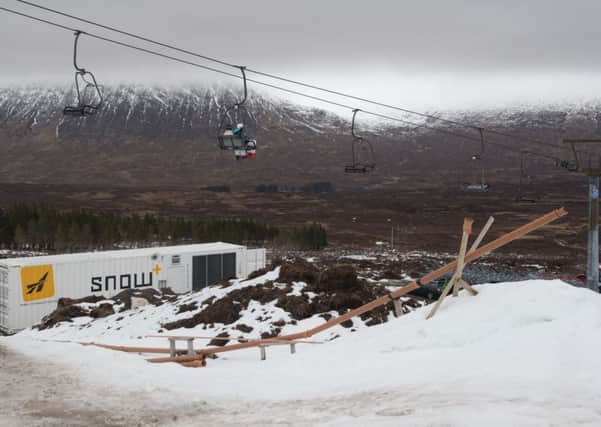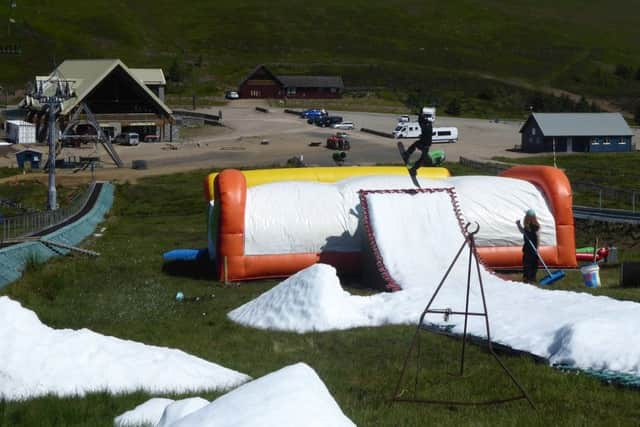How Snowfactories are revolutionising the Scottish ski industry


One of the biggest problems with skiing in Scotland has always been reliability, or rather, a lack of it. Some years the isobars align and we’re gifted with plenty of snow and periods of high pressure, but others bring mild temperatures and excessively strong winds, which can mean the season never really gets off the ground.
The winter of 2016/17 was an example of the latter. The weather lottery did not work in favour of Scottish winter sports, which resulted in Glencoe ski resort managing to open for barely a month in total, making it their worst ski season on record. Stoic visitors who ventured onto the sparse slopes on the rare days when they were able to open were treated to conditions described by owner and managing director Andy Meldrum as “agricultural”.
Advertisement
Hide AdAdvertisement
Hide AdDeciding it was time to take action, he set about looking at ways to improve their snowmaking facilities to prevent such a disaster from occurring again.


“We already have conventional snow cannons at Glencoe but due to the high humidity, frequent strong winds and the lack of long periods of cold weather on the west coast of Scotland, we have only had limited success with them. Being able to make snow in any weather has always been a goal, but things came to a head in the 2016/17 season when we only managed to ski for 32 days with very poor conditions. It was at this stage that we decided to seriously look at the Snowfactory technology.”
TechnoAlpin Snowfactories are a type of snow cannon that can produce snow in temperatures of up to 25 degrees, and in any conditions. The machines, which have already proven to be effective in Eastern Europe, Australia and New Zealand, use an innovative cooling technology to freeze water without using any chemical additives, and can produce up to 100 cubic metres of snow per day.
Although the technology has existed for around 30 years, Meldrum never thought it would be possible to bring it to Glencoe, and with woeful profits from such a dire season, it was looking less likely than ever. With much of the resort’s budget having been committed to a new chairlift and access road, Meldrum had to find an alternative way to raise funds for the Snowfactory, which is when he came up with the idea to use crowdfunding.
“After the very poor 2016/17 season we had no money in the bank and a lot of disappointed skiers,” he said. “Crowdfunding was not only necessary to raise funds, but also a great way to gauge support for the technology.”
With hefty project costs of £430,000, Meldrum set up a crowdfunding campaign to attempt to raise £190,000, with the remainder to come from future profits and support from Highlands and Islands Enterprise (HIE). Meldrum describes the success of the crowd funding campaign as “both amazing and slightly disappointing.”
“It was amazing from a customer point of view, as we had more than 500 customers supporting us, but it was slightly disappointing from a business point of view. While we got great support from some of our suppliers and local businesses, many of those who will benefit most from us having guaranteed snow and a set opening and closing date for the season didn’t support the campaign.”
Despite only reaching around a third of the target, the resort still managed to raise enough funds to hire a Snowfactory for winter 2017/18, and the 16-ton machine was installed in the car park, churning out snow from mid-January until the end of March.
Advertisement
Hide AdAdvertisement
Hide AdHIE funding also helped CairnGorm and The Lecht ski areas trial a Snowfactory, with each resort installing the machine for half of the season.
Ironically, 2017/18 turned out to be an excellent season, and Glencoe managed to open from 28 November to 7 May without assistance from its new resident. However, the machine was far from redundant, says Meldrum.
“Having the Snowfactory was a bonus. It made very little difference to our commercial viability but improved the customer experience as it allowed skiing back to the car park for more weeks than ever before. However, it’s poor seasons like 2016/17 where the unit will show its worth.”
Despite the excellent conditions at Glencoe, the season had got off to a slow start at The Lecht, as general manager Pieter du Pon recalls: “The season was good in parts but there was little snow over the Christmas period. When the Snowfactory arrived at the end of January the hills were brown, with no snow at all. The key periods for us are the Christmas and New Year holidays and the half-term weeks in February, so with the factory we can now guarantee snow at these times”.
They even used the machine to make snow for a successful GB Park and Pipe training camp in June, when it was 24 degrees. According to Andy Meldrum at Glencoe, feedback on the project has been “almost 100 per cent positive”, with mountain users and local businesses acutely aware of the advantages that a snow-sure ski season will have for both snowsports enthusiasts and the local economy.
However, he does follow with a caveat. “The only criticism has been on environmental grounds, but we are already exploring how we can operate it using alternative power, such as solar, wind or micro hydro.”
At The Lecht they’re already “turning green energy into white snow,” as the resort’s managing director, James McIntosh describes it, by using the Snowfactory at night when they have spare capacity from their wind turbine. The trials have been such a success that the Snowfactories will now be permanent features at Glencoe and The Lecht, with both resorts running the machines from early November to ensure a guaranteed opening date of 1 December, and sufficient coverage to offer snowsports until mid-April, regardless of what nature decides to throw at them.
Having a guaranteed opening and closing date is something that’s never been possible before, and should have a positive impact on not just the Scottish ski industry and local businesses, but also on Scottish tourism in general. As du Pon puts it: “Being able to guarantee that we’ll have the nursery slopes open on 1 December until mid-April will allow ski schools to take bookings, hotels to encourage customers to come to Scotland, and children to try something new. We have to compete with the resorts in the Alps, especially with easy direct flights from Scotland, but the ease of just getting in the car and going for the day, knowing that you’ll definitely get some snowsports, can only be positive for Scottish tourism.”
Advertisement
Hide AdAdvertisement
Hide AdPoor winters are nothing new in Scotland, and in years gone by the ski
areas have just had to roll with the punches. However, the arrival of Snowfactories at the nation’s ski resorts should make abysmal winters like 2016/17 a thing of the past. ✱